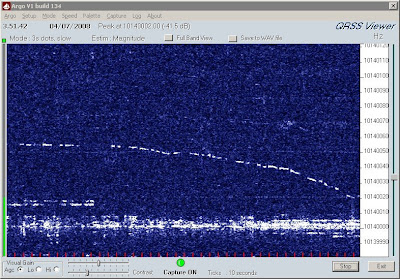
As you can probably tell, I was really pleased to get my little QRSS station in operation. But then came some icing on the cake: Vernon, VE1VDM, sent a screen shot (above) that showed the unmistakable traces of my somewhat chirpy signal. Look around 10140020 Hz . See those kind of droopy dashes? They're mine! (Johan, ON5EX, called them "Italian tears.") Hooray! Crossing the pond on 200 milliwatts!
Of course, this is no big deal in the QRSS world. 200 milliwatts is decidedly QRO for these fellows. I feel some pressure to reduce power. I also feel the urge to clean up the chirp, but then again, the Italian tears make spotting the signal easier.
For a great explanation of how QRSS allows you to pull signals out of the noise see ON7YD's excellent article:
http://www.qsl.net/on7yd/136narro.htm
The online "grabbers" add a very interesting dimension to this. You can watch the band from stations around the world simultaneously. Take a look at I2NDT's grabber compendium:
http://digilander.libero.it/i2ndt/grabber/grabber-compendium.htm
Here's something else that I found really cool: I can watch the grabbers on my Blackberry! So, the other day, with my beacon on, as I made my way through central Rome on the 63 bus, I pulled out the Blackberry and opened ON5EX's grabber page. There I could see my droopy dashes at 10140020. Now I've got my eye on the grabber of Laurence, 9V1LF, in Singapore; I hope to put some Italian tears on his screen soon.
Guys, this real "essence of QRP" stuff. I'm reading Ade Weiss's book on the history of QRP, and I often find myself thinking that The Old Man and the QRPers of yesteryear would very much approve of QRSS.
It may seem complicated, but it is not. The transmit systems are just milliwatt crystal-controlled transmitters and some sort of keyer (mine is from K1EL). For receive, all you need is a cable from your receiver to your soundcard, and some free software.
We need more QRSS activity from the States. When will AA1TJ put one of those Zener Diode rigs on 10140030?








































